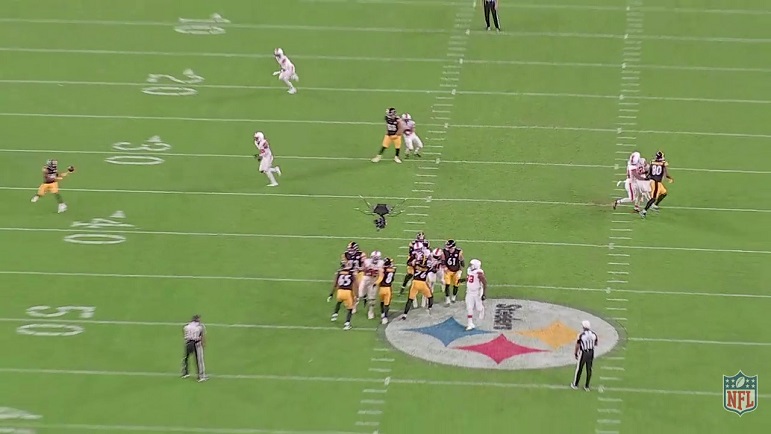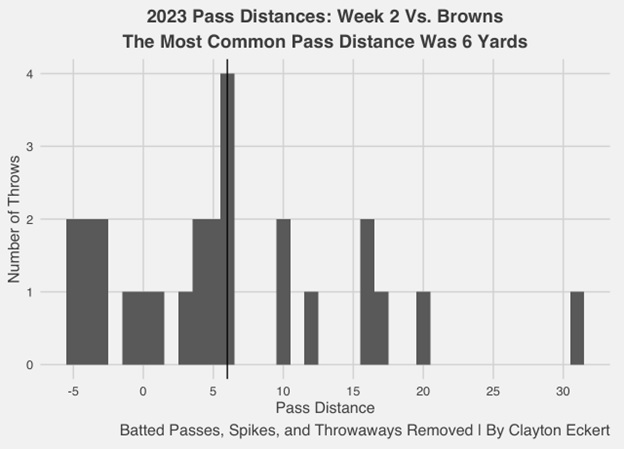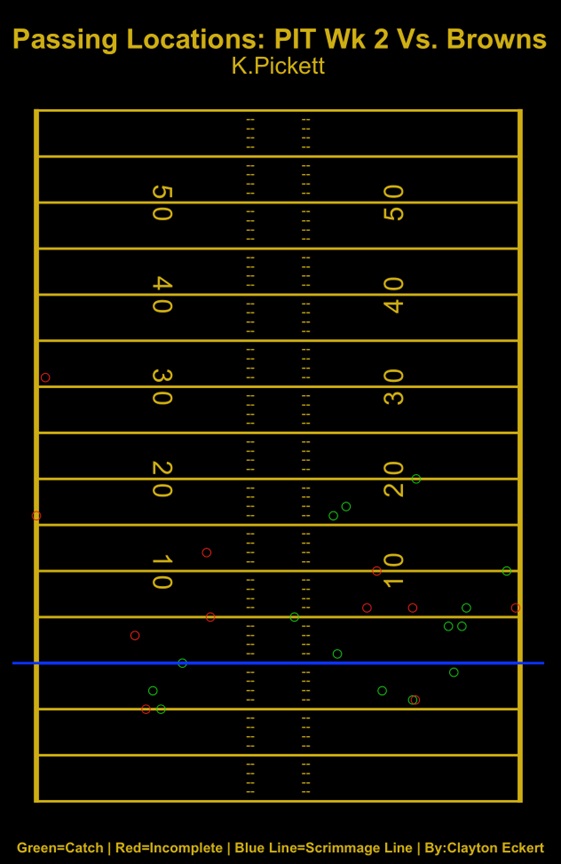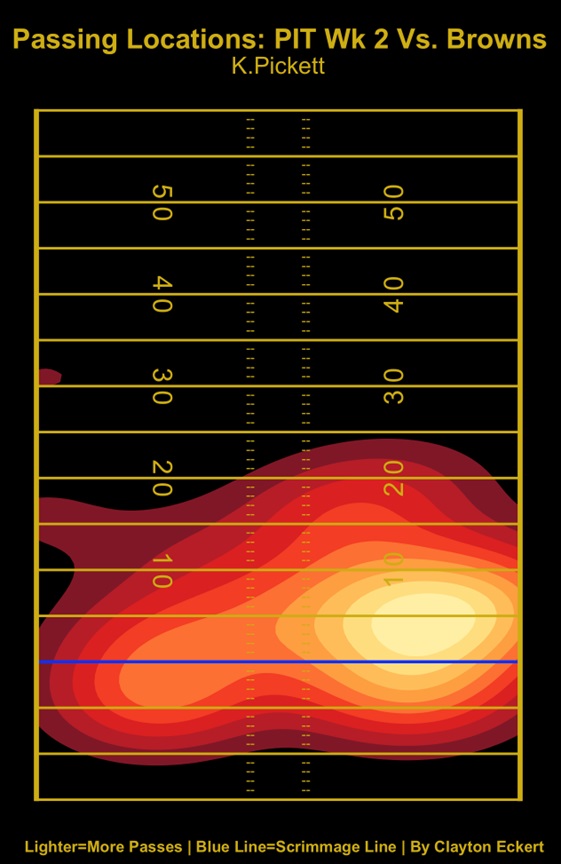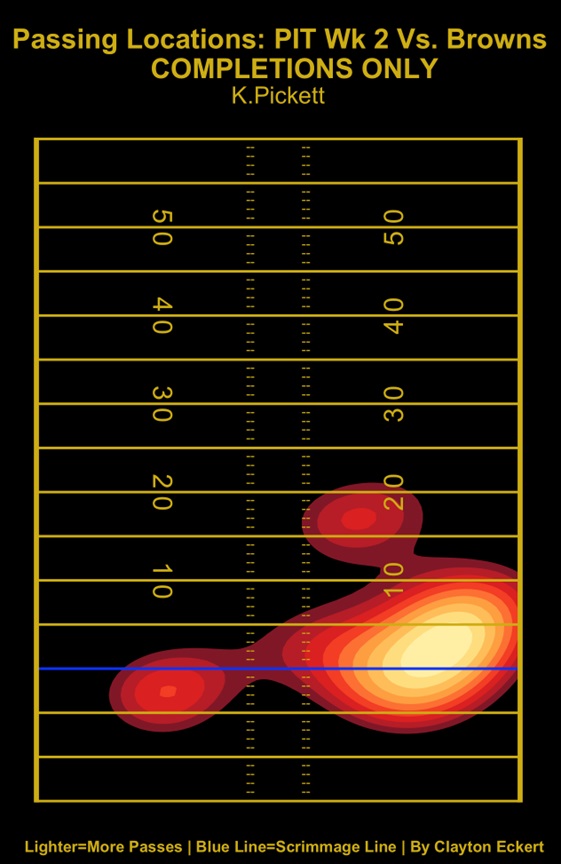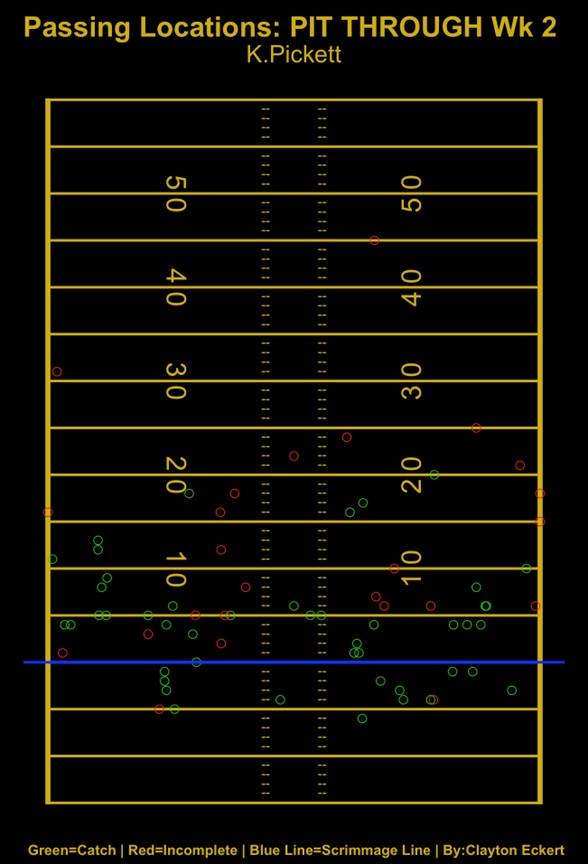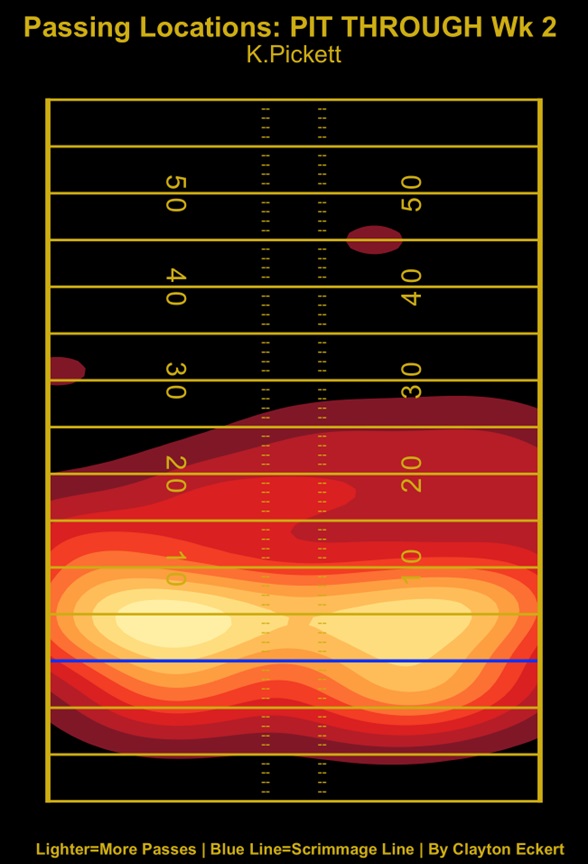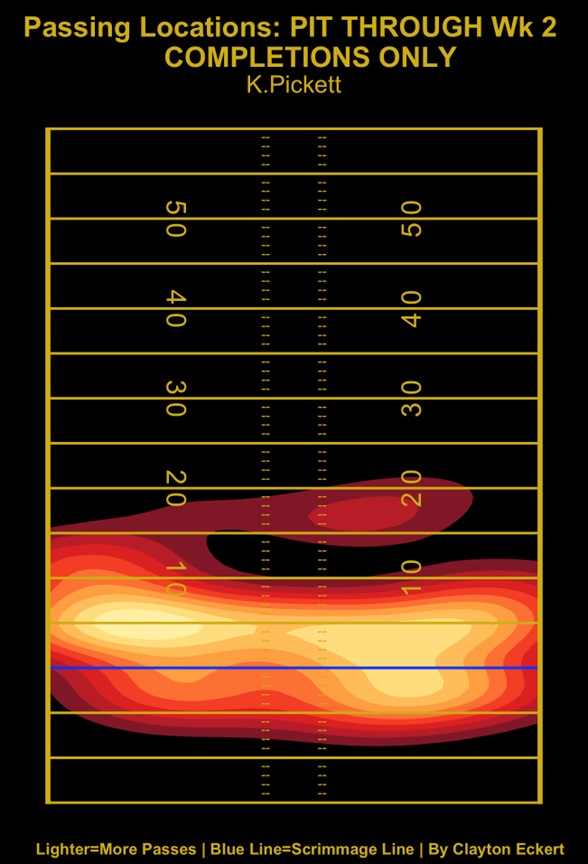What a crazy Week Two win against the Cleveland Browns with Pittsburgh now 1-1. For the second season, I am charting, visualizing, and providing takeaways for the all-important quarterback position for the Steelers.
Couple of notes before we jump in. Thanks to Thomas Mock for his great work helping me learn much of what I’m using in the series visually. Spikes and clear throwaways are removed due to being the correct situational decision, along with batted passes at the line of scrimmage that affect the intended pass location. This week, two throwaways and two batted passes were removed.
QB Kenny Pickett, unfortunately, had another poor game overall. He went 15-of-30 for 222 yards, one touchdown, one interception (a dropped interception as well), two sacks, and a 71.8 passer rating, slightly better than the opener (68.4). Decision-making and accuracy were still inconsistent, along with another slow start from the offense.
Let’s start with a simple view of the 26 charted passes, with number of throws at each pass distance:
The chart highlights six yards as the most common pass distance, and the majority of the other attempts shy of that mark. The most common pass distance was a bit farther than a typical week, 5-10 air yards at 30.8-percent.
This included the first pass of the game on the move to WR Allen Robinson II on an out route. He was wide open but the throw off-target, with Robinson having to jump and fall on the catch, which negated YAC opportunity. The following play was right back to him on a slant that was well defensed. Pickett had a bad interception on the first drive, staring down a slant route by WR George Pickens, which the safety read and undercut on third and 3. The aforementioned near pick opened the third quarter, with Pickett throwing it right to the defender. No one open on first down, just throw it away. Another instance was a third-and-two fail, a quick decisive throw to Pickens that was well defensed and broken up.
Zero to five air yards is usually the most common pass distance, tying for second this game at a 26.9 rate. One play was an excellent one, scheming RB Jaylen Warren open for the catch at the line of scrimmage, taking advantage of the blown coverage with 30 in YAC on third and 3. This was also the first chain-moving play for the offense at 12:48 in the second quarter. The following pass was thrown well behind Calvin Austin III, who was open but unable to spin around to make the catch.
Warren provided another great YAC play on third and 10, making the catch at one air yard for an 11-yard gain. The following instance included another big hit on Pickett, this one from a blitzing defensive lineman coming free right up the middle and Pickett did nice job getting it to George Pickens on the successful stop route (failed hurdle attempt). WR Miles Boykin made a nice, contested catch at four air yards as well, but on a second and 21 in the third quarter.
Lots of behind-the-line passing, at a high 26.9 percent. Warren was the first target, catching it four yards behind the line with great YAC and effort to churn for 15 yards but failing to convert the third and 18 (nice blocks from Austin and Robinson). On the next drive, Pickett found WR Gunner Olszewski, who was hit hard, injured, and fumbled for a turnover on his lone snap on offense. Harris was also targeted here as you’d expect, one at minus-5 air yards, only able to get back to the line. A couple plays later was a rare play-action, but Pickett and Harris tripped each other, then dropped the pass.
A TE screen as well, which was frustratingly Pat Freiermuth’s only target (face palm), for just two yards. The next was quick pressure allowed (left tackle Dan Moore Jr.), with Pickett under-handing it to Warren to avoid the sack, and it fell incomplete. The last was also frustrating, a screen pass to Warren on third and 16 with the Steelers down three points in the third quarter, going for 10 yards. Felt like living in your fears, ugh. Wild, messy, poor results overall.
Just over 15 percent (15.4) of passes were 15-20 air-yards. The first was the touchdown to Pickens, Pickett looking off the coverage and hitting him wide open over the middle despite a big quarterback hit allowed by RT Chukwuma Okorafor with double explosive YAC for the triple explosive 71-yard touchdown. Great to see for a Pittsburgh offense that has struggled with big plays. Late in the first half on third and 10, Pickett was a bit antsy and rolled left, throwing late to Pickens on the sideline incomplete (broken up). Another third and 10 was a great play, with good protection allowing Pickett to go through his progressions and find Pickens over the middle, a nice route to get open for 25 yards and the conversion. More please!
Ten to 15 air yards came in at 11.5 percent. The first was an inaccurate high pass from Pickett, an in-breaker against tight coverage on Pickens. My favorite play at this distance was a great throw and contested catch by Austin on the sideline for 10 yards, a third-and-eight conversion in the second quarter. A couple plays later accuracy issues crept up again, Pickett throwing low and ahead of another in-breaking route to Pickens. Hope their connection improves moving forward.
The least common pass distance unfortunately was explosives (7.7 percent). Just two attempts, one a play-action that Pickett underthrew to Austin on a go route, Pickett seemingly wanting him to break off the route. The other was a great route from Pickens, finding a spot against zone, and Pickett hitting him for the 23-yard gain. Encouraging after missing a similar look earlier.
Here are the dots of completions and incompletions for Week Two:
Whoof. Explosives jump out right away, with just two attempts, going 1-of-2. Fifteen-20 air yards was successful though, going 3-of-4, including two explosive plays and the 71-yard touchdown. One-of-3 at 10-15 air-yards and 4-of-8 at 10-plus air yards, with that quantity and quality frankly unacceptable to keep up consistently in the NFL.
Only one pass between the hashes is also notable, after seeing a bit more in Week One. Five-of-9 between the numbers, with all four incompletions coming at five air yards or more, including the interception. Pickett favored the right side outside the numbers, going 7-of-10 and a touchdown, compared to 0-of-4 and an interception to the left. Also, only three completions to the left, all painfully at or behind the line of scrimmage. In totality, 7-of-14 outside the numbers, and 8-of-12 on/inside the numbers. Almost 54 percent (53.8) outside the numbers, compared to 51.1 percent on/between the numbers more frequent in the opener.
Now for the heat maps, with all the charted passes for the game, then completions only:
Yikes. This highlights the lack of explosive air yards for the second week in a row. The completions-only view emphasizes the struggles to the left side of the field against the Browns. Week Two was unfortunately many of the same issues, with the Steelers needing to establish the run to hopefully open up the pass. Need to start the game stronger, hopefully seeing better accuracy and decision making from Pickett, and hope to see more explosive air yards in Week Three against the Raiders.
Now let’s look at all 71 charted throws this season, with frequencies for the season and previous averages:
No. 1. 0-5 air-yards: Season 32.4-percent. Previously 35.6-percent.
No. 2. 5-10 air-yards: Season 31-percent. Previously 31.1-percent.
No. 3. Behind the line: Season 21.1-percent. Previously 17.8-percent.
No. 4. 15-20 air-yards: Season 12.7-percent. Previously 11.1-percent.
T-No. 5. Explosive (20+ air-yards): Season 9.9-percent. Previously 11.1-percent.
T-No. 5. 10-15 air-yards: Season 9.9-percent. Previously 8.9-percent.
The most notable changes in Week Two were an uptick in behind the line passes (largely unsuccessful), as opposed to 0-5 air yards, and explosives taking a hit. Game situations factor into the results, but still want to see more explosiveness, with just six explosive gains in the passing game through two weeks.
Here are the dots for all 2023 charted attempts, along with completion rates by distance:
Behind the line: Season 13-of-15 (86.7 percent). Previously 8-of-8 (100 percent).
0-5 air-yards: Season 18-of-23 (78.3 percent). Previously 13-of-16 (81.3 percent).
5-10 air-yards: Season 14-of-22 (63.6 percent). Previously 11-of-14 (78.6 percent).
10-15 air-yards: Season 4-of-7 (57.1 percent). Previously 3-of-3 (100 percent).
15-20 air-yards: Season 4-of-9 (44.4 percent). Previously 1-of-5 (20 percent).
Explosive: Season 1-of-7 (14.3 percent). Previously 0-of-5 (0 percent).
Largely every rate dipped in Week Two. We did see an improvement, particularly at 15-20 air-yards, which hopefully continues, and the Steelers finally got on the board with an explosive air-yard completion. That painful 14.3 percentage must improve soon though.
To close, here are the heat maps for all charted passes, along with the completions-only heat map (brace yourselves):
Rough. Pickett is only 8-fo-21 on attempts of at at least 10 yards (38.1 percent), hence the painful drop off on the completions-only chart. Lots to improve for sure. Here’s to hoping for better quality across the board against the Raiders.
Thanks for reading and let me know your thoughts in the comments.

